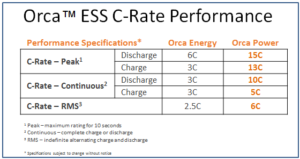This is the fourth article in a series highlighting the five remarkable design features incorporated into the Orca™ Energy Storage System (ESS) product line design—a design that earned Corvus Energy the Electric & Hybrid Marine Technology 2017 Innovation of the Year award, as well as the BC TIA Technology Impact Award for Excellence in Product Innovation.

The Orca product line consists of two distinct ESS platforms—Orca Energy and Orca Power—each using different battery cell technology with optimized performance characteristics to match high energy demands or high power demands, respectively. In this article, we explore the technology and ideal uses of Orca Power ESS in maritime applications.
Industry’s Highest Discharge Rates
Discharge and charge rates of batteries are specified in a measure called the “C-Rating”. The C-Rating of a battery (or cell) indicates the maximum safe continuous discharge or charge rate. For example, a C-Rating of 10C means it can be discharged at 10 times that pack’s capacity. Continuous and peak C-Ratings are generally specified.
Orca Power ESS can discharge at peak rates of 15C and continuous rates of 10C—rates that simply cannot be attained by any other ESS supplier in the industry.
What are some of the applications that benefit from these high discharge and charge rates? Those with variable loads, says Sean Puchalski, Vice President of Strategic Marketing at Corvus Energy. “The economic benefit of the ESS is derived mostly from load leveling, peak shaving, and spinning reserve. The first two functions in particular are more pronounced in a vessel that must respond to high variation in propulsion loads.”
ESS-Assisted Dynamic Positioning and Peak Shaving Reduces Costs 20-30%
Bjørn-Johan Vartdal, Project Manager at Det Norske Veritas (DNV) agrees that vessels, such as offshore drill platform supply vessels, can benefit from a hybrid-electric system and integrated ESS. “When operating on dynamic positioning, there is a major fuel saving potential. When in harbour, too, the ship should be able to operate on the fuel cell and its battery power alone, which will reduce emissions significantly.”
To maintain the position of the vessel amid wind and waves, thrusters must respond quickly and dynamically. Traditionally, diesel or LNG generators have powered the thrusters, but slow generator ramp rates delay response time. Further, generators are typically sized for peak loads and may often operate in inefficient ranges. Consequently, a hybrid-electric system that can quickly draw high power from an ESS helps to both improve ramp rates and offset peak power demands—a practice known as peak shaving.
The primary benefit of a hybrid system for offshore supply vessels is a 20-30% reduction in fuel consumption and CO2 emissions achieved through smoother and more efficient operation of the generators. Moreover, generators can often be sized smaller to handle base loads as the peak loads will be absorbed by the ESS. So in addition to fuel efficiency, peak shaving may reduce generator running hours and may even negate the need to turn on additional generators.
High C-Rate Means Fast Charging
Let’s not forget that the ESS needs to be charged. Orca Power ESS can charge at peak rates of 13C and continuous rates of 5C, meaning that Orca Power ESS batteries can be quickly charged from shore charging stations and via energy recovery systems.
An example of a shore station ESS that takes advantage of quick discharge/charge using a Corvus ESS is the all-electric Norled ferry, Ampere. The ferry pauses only 10 minutes to unload and load vehicles. The shore ESS at each quay stores energy from the grid and performs a rapid battery-to-battery energy transfers with the on-board ESS while the ferry is docked. The top-up charges the ferry receives after each crossing allows it to make 34 crossing each day before receiving a full charge from the grid overnight.
Due to the quick charge rates, energy can also be recovered and stored in the ESS from port gantry cranes or off-loading equipment on vessels lowering their payload. Again, the high C-Rating means that a significant portion of the potential energy in elevated payloads can be converted into stored energy, further improving energy efficiency and ESS return on investment.
Rapid Adoption of Orca ESS
Whether Orca Power ESS is selected for its high discharge/charge rates and dynamic response, or Orca Energy ESS is selected for its high energy density and low cost per kWh, Orca ESS is a practical and economical solution for an increasing number of marine applications. Since its introduction in June 2016, Orca ESS has been selected for over 30 projects totaling over 25 MWh, and the technology will only continue to improve the viability of our systems in a greater range of maritime applications.
This concludes the fourth in a series of articles about what makes Corvus Energy ESS different from all the others. Subscribe to Corvus Energy Updates or Follow Corvus Energy on LinkedIn to receive all articles as they are posted.
View the preceding articles entitled, Five Remarkable Features of an Award-Winning Marine Energy Storage System, Energy or Power – Which does your electric or hybrid marine application need? and High Energy Density is the Key to Economical Electric & Hybrid Energy Storage Systems

